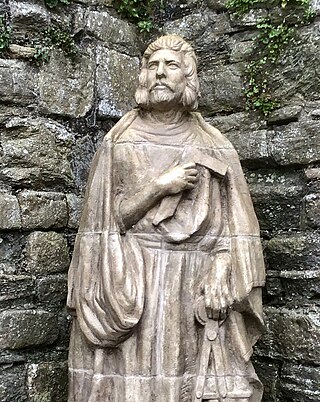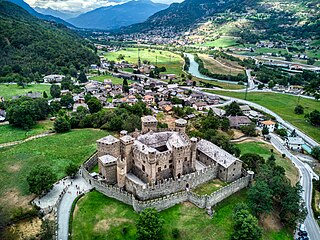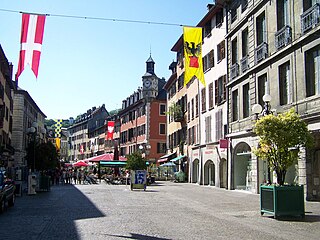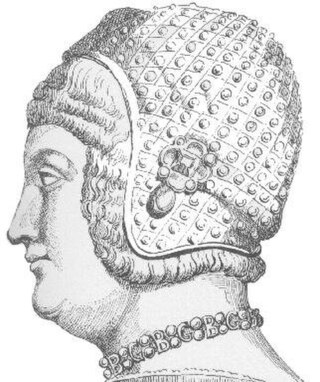Savoy Castle may refer to:
Peter II, called the Little Charlemagne, was Count of Savoy from 1263 until his death in 1268. He was also holder of the Honour of Richmond, Yorkshire, England, the Honour of the Eagle also known as the Honour of Pevensey and the Honour of Eu also known as the Honour of Hastings. His significant land holdings in Sussex were also marked by his holding of the wardship of John de Warenne, 6th Earl of Surrey which brought with it lands centred upon Lewes castle. Briefly, from 1241 until 1242, castellan of Dover Castle and Keeper of the Coast. In 1243 he was granted land by the Thames in London where he later built the Savoy Palace.

Philip I was Count of Savoy from 1268 to 1285. Before this, he was Bishop of Valence (1241–1267) and Archbishop of Lyon (1245–1267).

Francis Hyacinth was Duke of Savoy and ruler of the Savoyard states from 7 October 1637 to his premature death the following year, under the regency of his mother Christine Marie.

Victor Amadeus II was the head of the House of Savoy and ruler of the Savoyard states from 12 June 1675 until his abdication in 1730. He was the first of his house to acquire a royal crown, ruling first as King of Sicily (1713–1720) and then as King of Sardinia (1720–1730). Among his other titles were Duke of Savoy, Duke of Montferrat, Prince of Piedmont, Marquis of Saluzzo and Count of Aosta, Maurienne and Nice.

Master James of Saint George was a master of works/architect from Savoy, described by historian Marc Morris as "one of the greatest architects of the European Middle Ages". He was largely responsible for designing King Edward I's castles in North Wales, including Conwy, Harlech and Caernarfon and Beaumaris on Anglesey.

Harlech Castle in Harlech, Gwynedd, Wales, is a Grade I listed medieval fortification built onto a rocky knoll close to the Irish Sea. It was built by Edward I during his invasion of Wales between 1282 and 1289 at the relatively modest cost of £8,190. Over the next few centuries, the castle played an important part in several wars, withstanding the siege of Madog ap Llywelyn between 1294 and 1295, but falling to Prince Owain Glyndŵr in 1404. It then became Glyndŵr's residence and military headquarters for the remainder of the uprising until being recaptured by English forces in 1409. During the 15th century Wars of the Roses, Harlech was held by the Lancastrians for seven years, before Yorkist troops forced its surrender in 1468, a siege memorialised in the song "Men of Harlech". Following the outbreak of the English Civil War in 1642, the castle was held by forces loyal to Charles I, holding out until 1647 when it became the last fortification to surrender to the Parliamentary armies. In the 21st century the ruined castle is managed by Cadw, the Welsh Government's historic environment service, as a tourist attraction.

The Duchy of Lancaster is a private estate of the British sovereign. The estate has its origins in the lands held by the medieval Dukes of Lancaster, which came under the direct control of the monarch when Henry Bolingbroke, the then duke of Lancaster, ascended the throne in 1399. In 1461 King Edward IV confirmed that the Duchy would be inherited by the monarch, but held separately from the Crown Estate, the other assets which belong to the monarch.

The Aosta Valley is a mountainous autonomous region in northwestern Italy. It is bordered by Auvergne-Rhône-Alpes, France, to the west, Valais, Switzerland, to the north, and by Piedmont, Italy, to the south and east. The regional capital is Aosta.

Moncalieri is a comune (municipality) of 56,134 inhabitants about 8 kilometres (5 mi) directly south of downtown Turin, in Piedmont, Italy. It is the most populous suburb of Turin and it is notable for its castle, built in the 12th century and enlarged in the 15th century, which later became the favorite residence of King Victor Emmanuel II of Italy and of his daughter Princess Maria Clotilde of Savoy. It is part of the World Heritage Site Residences of the Royal House of Savoy.

Chambéry is the prefecture and largest city of the Savoie department in the Auvergne-Rhône-Alpes region of southeastern France. The population of the commune of Chambéry was 59,172 as of 2020, while the population of the Chambéry metropolitan area was 255,790. The city is located at the foot of the French Alps between Bauges and Chartreuse mountains, making Chambéry an important railway and highway crossroads.

Saluzzo is a town and former principality in the province of Cuneo, in the Piedmont region, Italy.
Emmanuel Philibert of Savoy, a name shared by several members of the House of Savoy, may refer to:
Savoia may refer to:

The Residences of the Royal House of Savoy are a group of buildings in Turin and the Metropolitan City of Turin, in Piedmont. It was added to the UNESCO World Heritage Sites list in 1997.

Barge is a comune (municipality) in the Province of Cuneo in the Italian region Piedmont, located about 50 kilometres (31 mi) southwest of Turin and about 45 kilometres (28 mi) northwest of Cuneo. The population numbered 7,589 as of 30 November 2019.
Govone is an Italian town of 2,294 inhabitants in the province of Cuneo in Piedmont.

Palazzo Madama e Casaforte degli Acaja is a palace in Turin, Piedmont. It was the first Senate of the Kingdom of Italy, and takes its traditional name from the embellishments it received under two queens (madama) of the House of Savoy.

Bona of Savoy, Duchess of Milan was Duchess of Milan as the second spouse of Galeazzo Maria Sforza, Duke of Milan. She served as regent of Milan during the minority of her son 1476–1481.

Louis I was the Baron of Vaud. At the time of his birth he was a younger son of the House of Savoy, but through a series of deaths and his own effective military service, he succeeded in creating a semi-independent principality in the pays de Vaud by 1286. He travelled widely in the highest circles of European nobility, obtained the right to mint coins from the Holy Roman Emperor, and convoked the first public assembly in the Piedmont to include members of the non-noble classes. When he died, his barony was inherited by his son.

Yverdon-les-Bains Castle is a castle in the municipality of Yverdon-les-Bains of the Canton of Vaud in Switzerland. It is a Swiss heritage site of national significance.